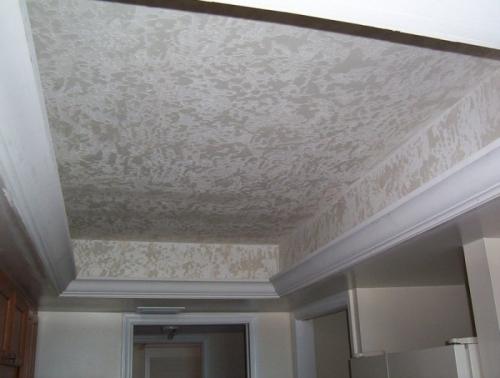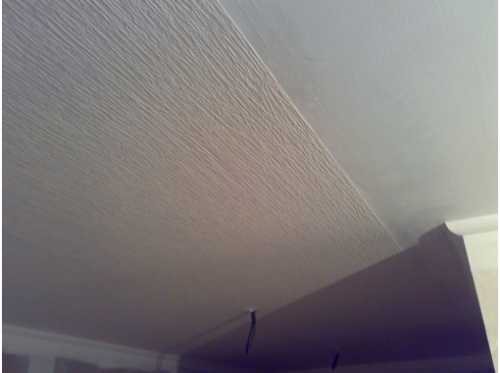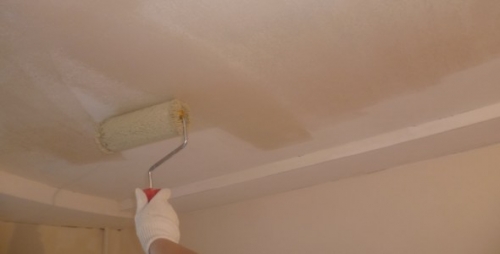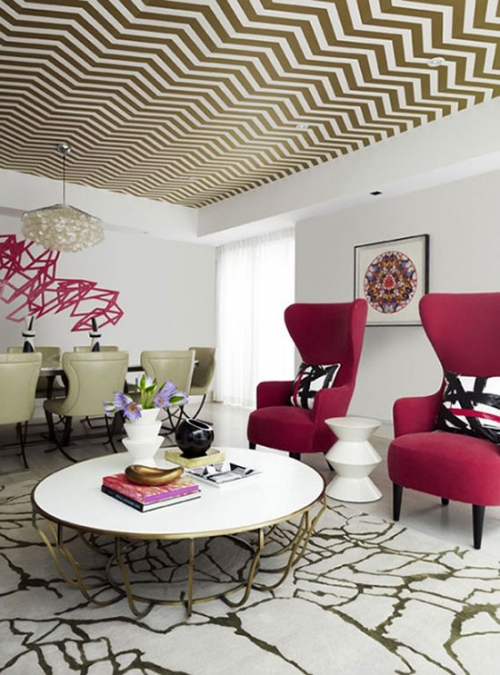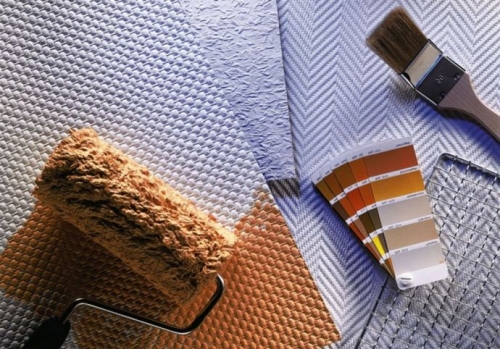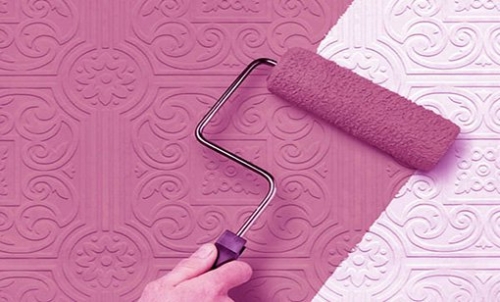Having settled the construction of your own home, one cannot but take into account the characteristics of the soil in the place ...
|
|
During the construction of any house, it becomes necessary to use reinforced concrete ... |
It is necessary to protect from water all surfaces and structures that can one way or another ... |
Wallpaper for the ceiling: Features of choice
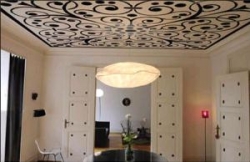
Despite the popularity of stretch ceilings or multi-level, complex structures, for example, from drywall, many apartment owners still want to see a surface over their heads pasted with wallpaper. And such a decision did not lose its relevance at all. On the contrary, thanks to various materials with rich colors and an abundance of prints, you can create anything on the ceiling: from a completely plausible illusion of a starry sky to a blooming paradise garden. Manufacturers have an answer for both high-tech interiors and classic rooms. The article will talk about the ceiling decoration with wallpaper.
Content:
- Non -woven wallpaper on the ceiling
- Vinyl wallpaper on the ceiling
- What is glass wallpaper?
- Liquid wallpaper on the ceiling
Non -woven wallpaper on the ceiling
A non -woven is a canvas from cellulose fibers and some ingredients to improve the quality of the material. Since 70% of such a coating is a natural component, the wallpaper is safe and vapor permeable. They are considered extremely durable, and are able to hide some minor surface defects. Many properties are attributed to them, but these are decisive when choosing and corresponding to reality:
- The coating is really able to disguise small irregularities and even reinforce microcracks. But this in no way cancels the preparatory stage of work before gluing wallpaper on the ceiling, when the surface is examined for the presence of defects and get rid of them in case of detection. It is not worth relying on a strong base and a relief drawing. Otherwise, even an expensive coating will look inaccurate and unacceptable.
Wallpaper on the ceiling photo
- The non -woven, as a basis, does not allow the wallpaper to stretch and soak. Comfort during work is the valuable quality of any material.
- The simplicity of pasting also lies in the fact that the application of glue does not occur on a wide canvas, but directly on the base. This not only increases the speed of the finish, but also facilitates the docking when you need to fit the pattern on neighboring canvases.
- There are no restrictions on sticking non -woven wallpaper. They perfectly decorate the ceiling from any material.
- Hygiene and non -toxicity are important characteristics, so you can safely decorate the ceiling in the children's room with non -woven wallpaper.
- Manufacturers guarantee that under the influence of sunlight, such a coating will not lose the brightness of paints.
- They are released, including for painting.
- Among the positive aspects of their application, the convenience of dismantling is called: when the upper layer can be easily removed without prolonged smearing. And after that, the ceiling will cover the flat layer of the non -woven base. A consumer with any income level can afford their acquisition, because the price of a roll depends on the fame of the manufacturer’s brand, texture, color or belonging of wallpaper to a particular collection.
Fleet wallpaper types
When buying, it is important to clarify what exactly the seller offers: wallpaper based from non -woven or an outnight coating itself.
- As it is easy to guess in the first case, we are talking about the fact that in the first case, textile fibers act as a substrate for a layer of finely porous vinyl. Their distinctive sign is the smooth back side, on which the pattern from the decorative coating does not duplicate.
- Completely non -woven wallpapers after rolling through rollers that give the structure have a relief on the back. They are considered durable, strong coating.
- When purchasing wallpaper for painting, the buyer receives a field for an experiment with color. To create unique interiors, this is a good solution. You can repaint the coating several times. The properties of nonsense will remain, and the wallpaper will not be deformed and will not lose textures.
- Some types of wallpaper for painting are already in tone. When purchasing this option, it must be borne in mind that the weaped kner can differ in color from the planned result.
Overwater wallpaper is also divided by the type of decorative layer:
- relief;
- smooth;
- corrugated.
Various drawings are applied to them: from geometric to floral ones, the texture can be almost invisible or pronounced. Plain wallpapers are represented as abundantly as multicolor. There is an opportunity for a choice, and therefore freedom for creativity.
How to stick non -woven wallpaper on the ceiling
The procedure for pasting is quite standard.
- You should get rid of the old coating, even if it is quite tightly holding paper wallpapers. Wallowing must be washed off. This must be done carefully so that the spots or poorly cleaned surface do not appear later on the wallpaper. As mentioned above, their dense structure is not a reason to neglect the preparatory stage of work.
- The surface is aligned.
- Even if the ceiling is not putty, it is worth covering it with a layer of primer and let it dry properly.
- Wallpaper is cut into canvases of the desired size.
- The adhesive composition must be bought specifically for non -woven wallpaper. It is quite economical, and applied directly to the ceiling.
- The canvases are glued to the end.
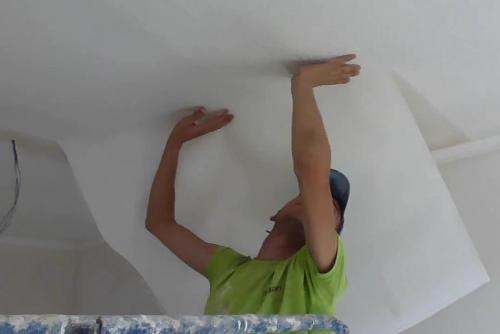
How to glue wallpaper on the ceiling video
Wallpaper painting for the ceiling
If non -woven wallpaper was bought with the calculation for further painting, then this should be done a few days after gluing the ceiling. Increased humidity in the room and a temperature of less than 15C is an occasion to increase the pause between the stages. The coating can be repainted up to seven times. Latex, water -based and acrylic paints are used.
- The floor is covered with polyethylene or covered with newspapers.
- If it is planned to use several colors or paint a certain part of the ceiling, then the stripes of painting tape must be glued along the boundaries of application.
- The roller must be carefully attended in the paint so that it is as well as absorbed into the fibers and does not flow out at the first attempt to raise a hand with a tool to the ceiling.
- Wherever the roller is not able to provide uniform staining use a brush.
- If you need to completely fill all the grooves and convexities of the picture, then a roller with a thick pile is used. A rubber hard tool will only apply color to relief elements of the pattern. When stained in this way, you do not need to press the roller too tightly to the wallpaper.
Ceiling wallpaper color
- Traditionally, light and calm tones of warm or cold gamut are used for ceilings, but not bright -exposed, but muffled. Recommendations can be violated if the design of the room provides flowering orchids or bright lace patterns on the ceiling.
- You can combine colors or several types of non -woven wallpaper. This will achieve the effect of multi -level ceilings or create a feeling of depth, space. So you can separate the perimeter of the surface from its central part or to do zoning (for example, decorate the ceiling only above the bed or recreation area in the living room).
- Plain varnished glossy surfaces can be successfully diluted with inserts with a pattern or other contrasting color.
Vinyl wallpaper on the ceiling
- Vinyl wallpapers along with non -woven ones are successful with those who wish to update the interior of their own apartment. They are distinguished by strength, a large number of variations on the theme of color, texture and drawing, but you can take care of them using wet cleaning.
- The basis for them can be paper or non -woven. The second option is preferable, but it costs more. The price of a PVC layer may also affect the price. Not too thick vinyl wallpaper is permissible only to wipe with a slightly damp cloth. More thorough specimens will easily transfer full cleaning with water.
Vinyl wallpapers are produced for painting. From other varieties you can highlight:
- coating from foamed vinyl without patterns squeezed out on the surface. They are quite dense, when pasting the ceilings with such wallpaper, small defects are hidden, including poorly plucked joints between drywall sheets.;
- vinyl coatings produced by hot embossing. They look originally due to the plausible imitation of a wide variety of materials:
- textured plaster with various patterns,
- stone,
- textile coating.
- Their second name is compact vinyl. They are considered particularly resistant to damage, are simple in operation. But such wallpapers are valued for a variety of decorative effects. Silkography is very popular today, but such a smooth surface will look perfect only on a carefully leveled base;
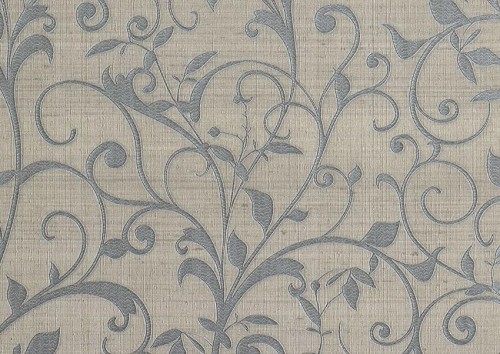
- chemical embossing Allows you to create another type of vinyl wallpaper inhibited. For their cleaning, cleaning agents can be used, and by moisture resistance they are considered real record holders among their own kind. Therefore, they can decorate the ceilings even in such a picky room with respect to finishing materials, like a kitchen.
What is glass wallpaper?
Glass wallpaper is not quite familiar material for pasting ceilings in the apartment. Various fiberglasses become a blank for yarn. From it, according to special technology, weave the basis on which various drawings are applied. This coating from quartz sand, lime, dolomite and soda is born. It is completely environmentally friendly, does not contain harmful impurities. Exceptional wear resistance is not the only advantage of this material.
- Non -combustibility. This statement does not require inspections. It is enough just to remember the composition of the wallpaper. They do not distinguish when heated by the substances harmful to humans and the environment, prevent the further spread of fire.
- They contribute to maintaining a good microclimate in the room.
- They are washed by any compounds for cleaning, do not attract dust.
- Very durable. This positive moment is important not only when working with the material. The surface pasted with such wallpaper receives additional reinforcement.
- Durability. Manufacturers claim that the service life of such wallpaper is 30 years.
- One day, glued glass wallpaper can be repainted up to 20 times. The number of operations will not affect the figure in any way.
- Glass wallpaper in the interior. This coating has an interesting embossed pattern. Most often, this is a Christmas tree or rhombus, however, many companies are engaged in the manufacture of material to order, and any print that interests the buyer will show off on the ceiling in his house. The main thing is that such a structure is suitable for any interior, it is only important to choose the right addition to it, for example, stucco molding for a classic style or with the help of color create a romantic atmosphere or give a strict look.
The nuances of the choice
It is important to know not only how to glue this material, but also how to choose it correctly. High -quality glass wallpaper will be the key to a long service life, and their appearance will be impeccable. This is especially significant when the wallpaper is selected for the ceiling in the kitchen and require periodic washing, especially above the hob.
Some tricks from unscrupulous manufacturers may look like this:
- the canvases are impregnated with a composition of starch, they thus become denser and more embossed. And after a piece of material is saturated with glue, which will dissolve starch, then the entire clear pattern will disappear with it;
- the fibers are specially combed, scaring them in order to achieve the same beautiful relief. After gluing, the effect achieved by artificially disappears.
Unfortunately, you can check such a fraud only after the trial piece of the canvas is glued to the surface. One of the indicators of high -quality coating is the presence of a long warranty period. If it is absent or insignificant is this reason to refuse to buy. Do not neglect and with a request to deploy a roll. It should be whole, without cracks and chopped fragments. If any, it means that the products are low. The edges of a worthy sample will not be shaken. They are processed and look like an even neat and sealed cut. Another guarantor of quality is the purchase of material from proven brands. But glass wallpaper from famous manufacturers has their own (for many consumers of a very significant) drawback. We are talking about high cost. In any case, before buying the goods of a brand or price category, it is better to look for reviews about it.
How to properly glue glass wallpaper on the ceiling
- Before gluing wallpaper on the ceiling, the surface should be leveled and cleaned of the old coating. First, the roll of the material is cut into canvases of the required length with a small stock for fitting. Further, you will need to determine the direction in which work will be carried out: sheets can be glued from the wall or from the middle of the ceiling. For convenience, an approximate line is applied along which the first piece of canvas will be located. The glue is applied with a roller directly onto the ceiling, so it will be better to pour a small amount into the painting tray.
- The adhesive should be applied with stripes that are slightly wider than glass wallpaper. Optimal width +5 cm to the size of the sheet. Places that are difficult to process with a roller (corners, areas near the pipes) pass with a brush or brush. The cut -off piece is applied to the surface with glue and leveled using a wallpaper spatula. You should not hardly iron the edges of the sheet if another fragment is glued next to the neighborhood. Such a trick will help during the combustion of two pieces.
- When carrying out paste work, it is important to make sure that the embossed pattern coincides. This is where the stock that was laid at the opening stage is useful. If you look closely, then the texture of the picture in the form of slightly protruding tubercles and small recesses will become visible. The next section is smeared with glue. Now it is necessary to attach a sheet of glass wallpaper close to an already glued canvas. Gently shifting the unimportant piece, you need to combine the pattern on both parts of the material. The distance for fitting is usually small and does not exceed several millimeters. Excess glue with a dry cloth is carefully removed along the entire length of the junction. After that, they pass the spatula and along the seam and along the newly glued piece.
- After completing the work of the window in the room should be tightly closed in order to avoid drafts. The process of drying in this case will take much more time, but this will affect the quality in the best way. In addition, experts advise protecting glass wallpaper from the hit of direct sunlight for the period of drying of the glue. The easiest way to close the windows with curtains, and if the repair is done in a room where there are no such ones, to seal the opening with newspapers.
Painting glass wallpaper
This stage is probably the most pleasant and less difficult to. This is not so much finishing work as creating interior design. However, some subtleties are still available.
- If it is planned to get a flat and plain color on the ceiling, then when stained, you should use a structural roller, which will evenly distribute the particles of the paint on the coating and imprint them into the texture of the canvases.
- Sometimes, according to a creative idea, the ceiling should have light veins in the basic color. Then you have to purchase a hard and dense foam (or rubber) roller. It will not provide such a filling of the material, and uncomplicated areas are formed.
- Inititude places and joints with the wall, according to tradition, are processed with a brush. You need to paint in thin layers, the total number of which should not be more than three. Before each new application, be sure to allow the previous layer to dry for at least 12 hours. For a guideline: the flow rate of 600 grams of paint per m. Small changes in this indicator are possible due to the density of the selected material is considered optimal. Very dense wallpapers will require more consumption and vice versa.
Which paint is better to choose. To work in residential premises, it is recommended to give preference to water -based paint, which used acrylic binding components. It is applied easily, dries quickly and does not have a sharp annoying odor.
Liquid wallpaper on the ceiling
Those who have not yet encountered this type of coating should take this material. At its core, these are not so much wallpaper as a type of decorative plaster.
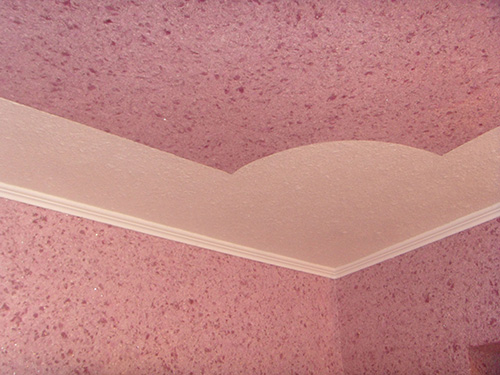
Distinctive features are considered:
- elasticity. They are well suited for rooms with complex surfaces: a large number of corners, niches, protrusions;
- liquid wallpapers are firmly adversely with any type of surfaces;
- this coating has a good antistatic effect. The dust on them practically does not settle. And as an option for cleaning, dry cleaning with a vacuum cleaner is proposed;
- the environmental friendliness of liquid wallpaper is determined by the composition: textile fibers (most often artificial silk), cellulose. The component that serves for them by the connecting substance is also obtained in the process of processing wood;
- vapor permeability;
- after application, liquid wallpaper is not only a decorative coating, but also play the role of the heat and sound insulation layer;
- simplicity of replacement. If part of the coating is damaged, the entire surface is not required. Only the damaged area of \u200b\u200bthe wallpaper is subject to replacement. The main thing is that no difference between new and old coating will be noticeable.
Minus one: Fear of moisture. In the kitchen, such a material will be inappropriate. But due to environmental friendliness and simplicity of repair, this type of wallpaper can decorate not only the ceiling in the children's room.
How to apply liquid wallpaper to the ceiling
- The preparation process is quite standard: the old coatings are removed, the surface is spit on if necessary. The application process suggests that the composition of the wallpaper will contain a certain amount of fluid that the putty does not tolerate. Therefore, before applying wallpaper, the ceiling can be painted with water -based paint. As an alternative at the level of alignment to gypsum putty, you can add PVA glue in a ratio of 3 to 1. If the ceiling is a design of GVL, then it is recommended to putty the entire surface, and not just the joints of the joints.
- It is better to knead the wallpaper using a construction mixer, then a large number of lumps are not formed in the process. First, warm water is poured into the prepared container, and a mixture is added to it with small portions with continuous stirring. After that, it is withstanded for about 20 minutes, again mixed intensively and the application begins.
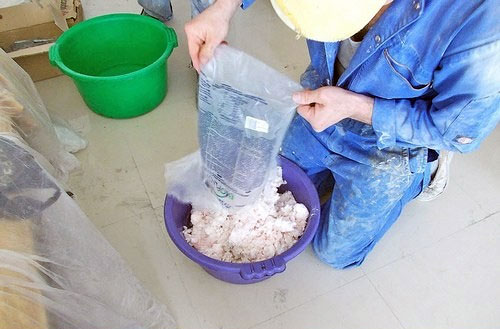
- The mixture is collected in small portions on the spatula and gently distributed over the surface. There should be no obvious noticeable transitions between the sections of application. Uneven, an empty plot is easy to eliminate if it is slightly moistened with water and smooth a spatula with a small amount of the mixture. Do not be zealous in the desire to make adjustments. It is not recommended to wet the wallpaper already applied.
- Depending on the thickness of the layer, humidity and temperature in the room, liquid wallpaper for drying will take from 12 hours to three days. Those who are not afraid of difficulties can try to combine several colors or perform a pattern of liquid wallpaper with one shade, and the background is poured with another contrasting color.
Do not be afraid to use new materials or use already proven coatings. Everything that is done in compliance with technology and with taste will never go out of fashion!

